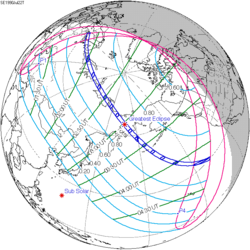| Total eclipse | |
 Totality viewed from La Serena, Chile | |
| Gamma | −0.6466 |
|---|---|
| Magnitude | 1.0459 |
| Maximum eclipse | |
| Duration | 273 s (4 min 33 s) |
| Coordinates | 17°24′S109°00′W / 17.4°S 109°W |
| Max. width of band | 201 km (125 mi) |
| Times (UTC) | |
| Greatest eclipse | 19:24:08 |
| References | |
| Saros | 127 (58 of 82) |
| Catalog # (SE5000) | 9551 |
A total solar eclipse occurred at the Moon's ascending node of orbit on Tuesday, July 2, 2019, [1] [2] [3] [4] [5] with a magnitude of 1.0459. A total solar eclipse occurs when the Moon's apparent diameter is larger than the Sun's and the apparent path of the Sun and Moon intersect, blocking all direct sunlight and turning daylight into darkness; the Sun appears to be black with a halo around it. Totality occurs in a narrow path across Earth's surface, with the partial solar eclipse visible over a surrounding region thousands of kilometres wide. Occurring about 2.4 days before perigee (on July 5, 2019, at 6:00 UTC), the Moon's apparent diameter was larger. [6]
Contents
- Visibility
- Oeno Island
- Chile
- Argentina
- Eclipse timing
- Places experiencing total eclipse
- Places experiencing partial eclipse
- Gallery
- Eclipse details
- Eclipse season
- Related eclipses
- Eclipses in 2019
- Metonic
- Tzolkinex
- Half-Saros
- Tritos
- Solar Saros 127
- Inex
- Triad
- Solar eclipses of 2018–2021
- Saros 127
- Metonic series
- Tritos series
- Inex series
- Notes
- References
- Additional sources
- External links
Totality was visible from the southern Pacific Ocean east of New Zealand to the Pitcairn Islands and the Tuamotu Archipelago and finally reaching the Coquimbo Region in Chile and central Argentina near sunset, with the maximum of 4 minutes 33 seconds visible from the Pacific Ocean. A partial eclipse was visible for parts of eastern Oceania, South America, and southern Central America. A total solar eclipse crossed a similar region of the Earth about a year and a half later on December 14, 2020.






















































































































